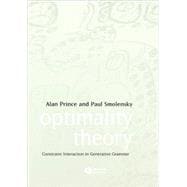
Paul Smolensky is Professor of Cognitive Science at Johns Hopkins University. His publications include Learnability in Optimality Theory (with Bruce Tesar, 2000) and Mathematical Perspectives on Neural Networks (edited with Michael Mozer and David Rumelhart, 1996).
| Prefactory Note | |
| Acknowledgments | |
| Preliminaries:.Background and Overview | |
| Optimality | |
| Overall Structure of the Argument | |
| Overview of | |
| Optimality in Grammar | |
| Core Syllabification in Imdlawn Tashlhiyt Berber | |
| The Heart of Dell & Elmedlaoui | |
| Optimality Theory | |
| Summary of discussion to date | |
| Generalization-Forms in Domination Hierarchies IBlocking and Triggering | |
| Profuseness and Economy:.Epenthetic Structure | |
| Do Something Only When: The Failure of Bottom-up Constructionism | |
| Generalization-Forms in Domination Hierarchies IIDo Something Except When | |
| Blocking, or The Theory of Profuseness:.Edge-Oriented Infixation | |
| Interaction of Weight Effects with Extrametricality | |
| Background: Prominence-Driven Stress Systems | |
| The Interaction of Weight and Extrametricality: Kelkar's Hindi/Urdu | |
| Nonfinality and Nonexhaustiveness | |
| Nonfinality and the Laws of Foot Form: Raw Minimality | |
| Nonfinality and the Laws of Foot Form:Extended Minimality Effects | |
| Summary of Discussion of the Except When Effect | |
| Except meets Only: Triggering and Blocking in a Single Grammar | |
| The Construction of Grammar in Optimality Theory | |
| Construction of Harmonic Orderings from Phonetic and Structural Scales | |
| The Theory of Constraint Interaction | |
| Comparison of Entire Candidates by a Single Constraint | |
| Ons: Binary constraints | |
| Hnuc: Non-binary constraints | |
| Comparison of Entire Candidates by an Entire Constraint Hierarchy | |
| Discussion | |
| Non-locality of interaction | |
| Strictness of domination | |
| Serial vs | |
| Parallel Harmony Evaluation and Gen | |
| Binary vs | |
| Non-binary constraints | |
| Paoini's Theorem on Constraint Ranking | |
| Overview of | |
| Syllable Structure Typology I: the CV Theory | |
| The Jakobson Typology | |
| The Faithfulness Interactions | |
| Groundwork | |
| Basic CV Syllable Theory | |
| Onsets | |
| Codas | |
| The Theory of Epenthesis Sites | |
| Constraint Interaction in Lardil Phonology | |
| The Constraints | |
| The Ranking | |
| Some Ranking Logic | |
| Ranking the Constraints | |
| Verification of Forms | |
| Consonant-Final Stems | |
| Vowel Final Stems | |
| Discussion | |
| Universal Syllable Theory II | |
| Ordinal Construction of C/V and Onset/Coda Licensing Asymmetry | |
| Associational Harmony | |
| Deconstructing Hnuc: Berber, Take 1 | |
| Restricting to Binary Marks | |
| Reconstructing the C and V Classes | |
| Emergent Parameter Setting via Constraint Ranking | |
| Harmonic Completeness of Possible Onsets and Peaks | |
| Peak- and Margin-Affinity | |
| Interactions with Parse | |
| Restricting Deletion and Epenthesis | |
| Further Necessary Conditions on Possible Onsets and Nuclei | |
| Sufficient Conditions on Possible Onsets and Nuclei | |
| The Typology of Onset, Nucleus, and Coda Inventories | |
| The Typology of Onset and Nucleus Inventories | |
| Onset/Coda Licensing Asymmetries | |
| An Example: Berber, Take 2 | |
| Simplifying the Theory by Encapsulating Constraint Packages | |
| Encapsulating the Association Hierarchies | |
| An Example: Berber, Take 3 | |
| Sufficiency and Richness of the Encapsulated Theory | |
| Inventory Theory and the Lexicon | |
| Language-Particular Inventories | |
| Harmonic Bounding and Nucleus, Syllable, and Word Inventories | |
| Segmental Inventories | |
| Universal Inventories | |
| Segmental Inventories | |
| Syllabic Inventories | |
| Optimality in the Lexicon | |
| Foundational Issues and Theory-Comparisons | |
| Thinking about Optimality | |
| Fear of Optimization | |
| The Reassurance | |
| The Connectionism Connection, and other Computation-based Comparisons | |
| Why Optimality Theory has nothing to do with connectionism | |
| Why Optimality Theory is deeply connected to connectionism | |
| Harmony Maximization and Symbolic Cognition | |
| Analysis of 'Phonotactics+Repair' Theories | |
| CV Syllable Structure and Repair | |
| General Structure of the Comparisons: Repair Analysis | |
| Persistent Rule Theory | |
| English Closed Syllab | |
| Table of Contents provided by Publisher. All Rights Reserved. |
The New copy of this book will include any supplemental materials advertised. Please check the title of the book to determine if it should include any access cards, study guides, lab manuals, CDs, etc.
The Used, Rental and eBook copies of this book are not guaranteed to include any supplemental materials. Typically, only the book itself is included. This is true even if the title states it includes any access cards, study guides, lab manuals, CDs, etc.